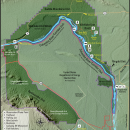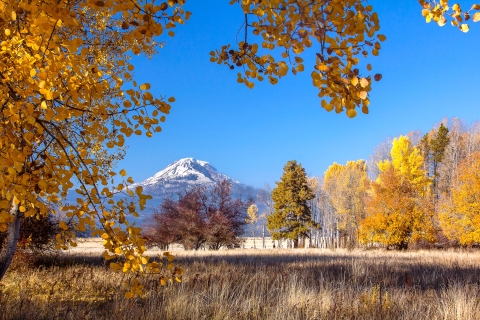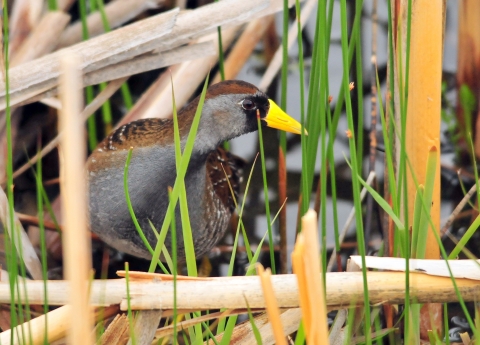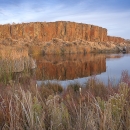Visit Us
The Monument is a land of extremes—heat and cold, water and desert, ancient and modern. While not an unduly dangerous landscape, caution needs to be taken when venturing out into it. There are few visitor facilities at present, and the visitor should plan on self-sufficiency. It's dry; bring plenty of water. River winds can capsize small craft; wear lifejackets. Some areas are remote; let someone know your destination and when you'll be back. Cell coverage is generally pretty good, due the flat landscape, but that shouldn't be your emergency plan. While rare and very shy, there are Pacific rattlesnakes, so don't reach into areas without first checking. The only real wildlife threats would be allergic reactions to insect or spider bites (e.g., black widow spiders).
Visitors should be prepared for minimal signing and primitive facilities. Our brochure is available HERE. If you'd like a paper version, just drop us a note with your name and address.
We also encourage you to visit The REACH Interpretive Center.
Warnings aside, the Monument is a fairly safe and pleasant environment. Obey signs and follow common sense, and you'll enjoy your visit to this unique national monument national monument
A national monument is established by executive order of the president or by Congressional legislation. The Antiquities Act authorizes the president to proclaim “historic landmarks, historic and prehistoric structures, and other objects of historic or scientific interest” as national monuments. The National Wildlife Refuge System helps manage two national monuments: Hanford Reach National Monument in Washington state and World War II Valor in the Pacific National Monument in Hawaii, Alaska and California.
Learn more about national monument and wildlife refuge.
Activities
The best time to visit the Monument is in the spring when the wildflowers are in bloom—April and early May—and in the fall when the rabbitbrush is in bloom. Fall also offers a special treat if you can get out on the river—the spawned-out salmon attracts scavengers like bald eagles and coyotes.
Trails
There are no maintained trails on the Monument, although a few paths follow existing corridors, such as service roads. A few social trails also exist, the main one starting at the White Bluffs Boat Launch and following the old wagon train route that supplied the Okanogan gold rush. This path heads out to sand dunes perched atop the White Bluffs. The Washington Trails Association describes several hiking opportunities, but be forewarned that these trails are not clearly defined or are primitive. For descriptions of these trails, visit the Washington Trails Association web site and search for "Hanford Reach National Monument."
Related Documents
Other Facilities in the Complex
The four refuges that make up the Central Washington National Wildlife Refuge Complex have little in common, other than being in the state of Washington. That makes the Complex a wonderfully diverse blend of habitats, species, and recreational opportunities. There’s something to be found by everyone that will pique their interest or pull them into the landscape. A geology buff? Visit Columbia National Wildlife Refuge, carved by the great floods of the last ice age. Need a scenic landscape to paint or simply unwind in? Conboy Lake is the spot. Interested in our history? The Hanford Reach National Monument is the place to investigate. Want to add to your birding life list? Check the spring and fall migrations through Toppenish.
Columbia National Wildlife Refuge
Columbia National Wildlife Refuge is a scenic mixture of rugged cliffs, canyons, lakes, grasslands, and sagebrush sagebrush
The western United States’ sagebrush country encompasses over 175 million acres of public and private lands. The sagebrush landscape provides many benefits to our rural economies and communities, and it serves as crucial habitat for a diversity of wildlife, including the iconic greater sage-grouse and over 350 other species.
Learn more about sagebrush . The mix of lakes, carved by unimaginable floods during the last ice age, and surrounding irrigated croplands, a result Grand Coulee Dam and the Columbia Basin Irrigation Project, combined with generally mild winters and the protection provided by the refuge, attracts large numbers of migrating and wintering mallards, Canada geese, tundra swans, and other waterfowl. As winter turns to spring and frozen lakes begin to thaw, additional waterfowl return in great numbers. The largest concentrations of ducks, geese, and lesser Sandhill cranes arrive on the refuge in March and April, at times numbering over 75,000 individuals. The arrival of the cranes and other waterfowl draw visitors from all over the region, centering around the annual Othello Sandhill Crane Festival.
Conboy Lake National Wildlife Refuge
Nestled near the foot of snow-capped Mount Adams in Washington’s Cascade Range, Conboy Lake National Wildlife Refuge is a scenic gem within the National Wildlife Refuge System. The refuge encompasses 6,574 acres of lush seasonal marshes and vibrant forested uplands that beckon to both visitors and wildlife. A blend of wetlands; grassy prairies; streams; and oak, pine, and aspen forests supports a diverse wildlife community. The rich habitat sustains thriving populations of migrating waterfowl and songbirds. The rare Oregon spotted frog breeds in wetlands throughout the refuge. Elk are plentiful and frequently seen along refuge roads. Conboy Lake also supports most of the breeding population of greater Sandhill cranes in Washington. As a national wildlife refuge national wildlife refuge
A national wildlife refuge is typically a contiguous area of land and water managed by the U.S. Fish and Wildlife Service for the conservation and, where appropriate, restoration of fish, wildlife and plant resources and their habitats for the benefit of present and future generations of Americans.
Learn more about national wildlife refuge , this living system will satisfy your longing for splendor and serenity, just as it did for the indigenous peoples, explorers, loggers, and ranchers who were first drawn to the valley’s plentiful resources.
Toppenish National Wildlife Refuge
Toppenish National Wildlife Refuge, established in 1964, is an important link in the chain of feeding and resting areas for waterfowl and other migratory birds using the Pacific Flyway. Although Toppenish was established primarily for migratory waterfowl, many other migratory and resident wildlife species live here, such as American bitterns, peregrine falcons, badgers and beavers. The refuge is a broad collection of habitats supporting a diversity of species. Natural wetlands, such as sloughs and oxbows, and artificial wetlands are flanked by riparian riparian
Definition of riparian habitat or riparian areas.
Learn more about riparian areas. Many species of migratory waterfowl and nongame birds, such as Virginia rails and savannah sparrows, use the wetlands for feeding and nesting activities. Native shrub-steppe—characterized by greasewood, Wyoming big sage, rabbitbrushes, bitterbrush, and native bunchgrasses, such as Great Basin wildrye, Indian ricegrass, Idaho fescue, and Sandberg bluegrass—once covered the upland areas. Loggerhead shrikes, long-billed curlews, California quail, Brewer’s and sage sparrows, and sage thrashers are only some of the animals that use the shrub-steppe. This diverse combination of habitats is a natural magnet to migratory and resident wildlife, alike.
Rules and Policies
We want to you come and enjoy the Monument, but we do have some rules—rules designed to protect wildlife, the fragile habitats, cultural resources, and other visitor's experiences.
Locations
The main access point for Hanford Reach National Monument.











